Short on time? Our pick for the best air conditioner is the Midea U and the Honeywell.
This is everything you need to know about finding the best tent air conditioner for your next summer camping trip.
Summer is prime camping season. The hot weather makes it the best time for swimming, fishing, and enjoying the outdoors.
But in the summer heat, a tent can quickly turn into a sauna. Confined polyester-based spaces are excellent for trapping heat and sunlight but not so great for climate control.
When you’re waking up in a tent ablaze with sunlight, drenched in sweat, you might start thinking to yourself, “wouldn’t it be great if I had an air conditioner in here?”
The bad news is that very few manufacturers have developed an air conditioner specifically for a tent.
The good news is that there are many portable AC units that you can adapt to become a tent air conditioner.
With that said, there are some challenges to air conditioning a tent. The first being that a tent’s walls aren’t usually insulated or airtight.
This means you usually need around 5,000 BTUs to cool down a two-person tent that doesn’t have insulation.
Power is also an issue. There aren’t many battery-operated air conditioners for camping out there.
Not to mention, it’s difficult for a battery to support the cooling power needed for a tent, and batteries always have a time limit.
Most of the products labeled “battery-powered air conditioners” are just personal cooler fans that use water to boost their cooling capabilities.
In general, you’ll need access to a power source to run your air conditioner. Still, you can solve all of these obstacles with some creative thinking.
If you’re ready to upgrade your camping experience and cool down this summer, use this detailed guide to find the best tent air conditioners that you can adapt to your tent.
Note: this post contains affiliate links, which help run this site at no extra cost to you so I can keep providing free travel advice and tips.
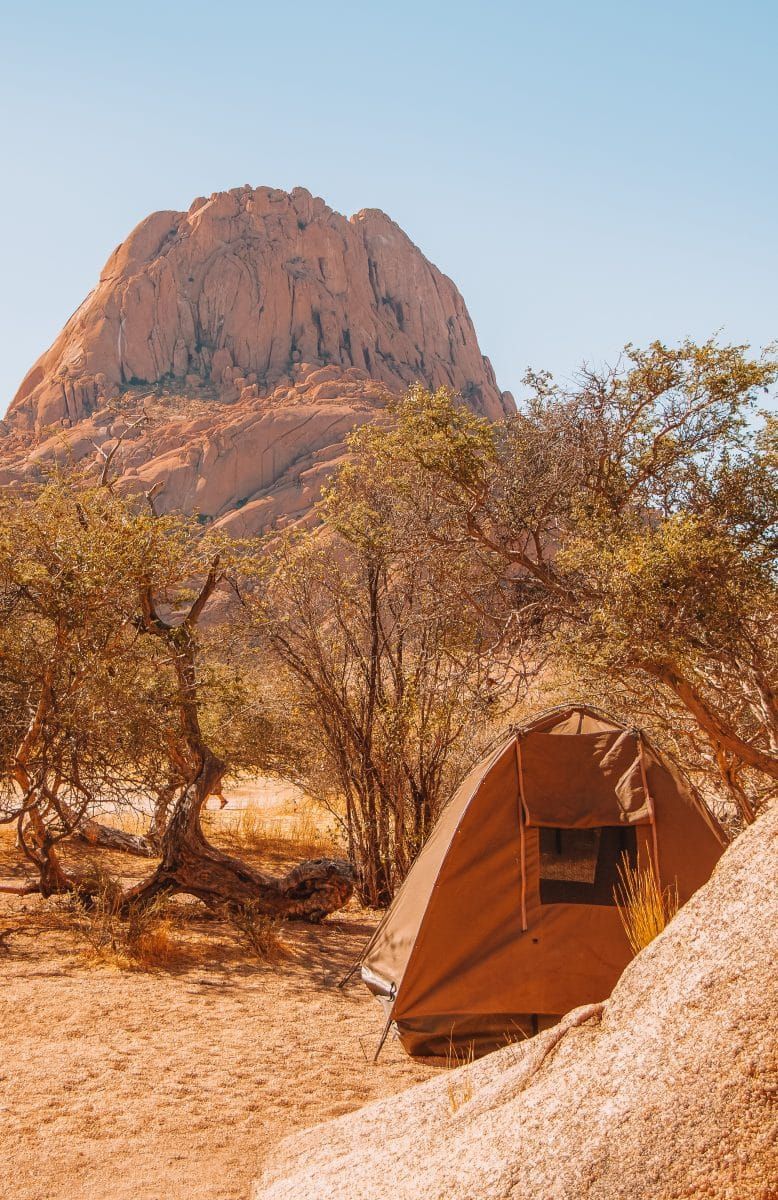
Short on Time? Here’s a Quick Look at Our Recommendations
- Uthfy Evaporative Air Cooler
- Honeywell Evaporative Air Cooler
- Zero Breeze Mark 2 Battery Powered Portable Air Conditioner
- Pro Breeze Smart Air Conditioner
- TOSOT Portable Air Conditioner
- Honeywell Portable Air Conditioner, Dehumidifier, and Fan
- Barton Portable Air Conditioner
- ZAFRO Portable Air Conditioner
- Koldfront Window Air Conditioner
- Midea U Inverter Window Air Conditioner
- AmazonBasics Window-Mounted Air Conditioner
#1 Uthfy Evaporative Air Cooler
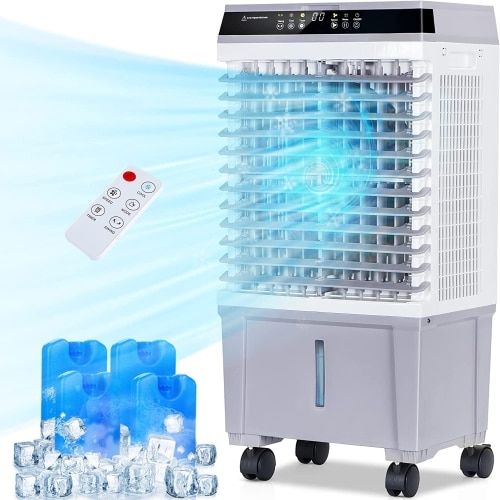
Star rating: 4/5
BTU: N/A
Size: 11″ x 15″ x 30.7″
Best for: Dry hot climates with some access to electricity
Evaporative coolers are a lower-energy alternative to traditional AC units that combine moisture with the power of a fan to cool the air.
Before you spring for a powerful, traditional, heavy air conditioner with a high BTU, you might want to consider this Uthfy Evaporative Air Cooler.
This evaporative cooler works by combining a powerful fan with a 5.3-liter water tank and two ice compartments, creating cool air as it blows through the unit.
This type of air cooling system is simple and doesn’t have the same kind of power draw that an actual air conditioner does.
Meaning, you should be able to run it on a less powerful generator while camping, it doesn’t need an exhaust hose, and you can set it up inside the tent.
On the other hand, evaporative coolers lack the same cooling capacity as traditional air conditioning units.
An evaporative cooler is essentially an upgraded fan.
It certainly helps make things more comfortable inside your tent, but it won’t actually remove the heat from the air in the same way that a traditional air conditioner can.
In any case, this evaporative cooler from Uthfy is compact and easily portable.
It can also run with relatively low noise levels, so it can keep you cooler on your camping trips without waking you up.
PROS
- Uses less power
- Doesn’t need to alter the tent
- Portable
CONS
- Not as strong as a regular AC unit
- Requires maintenance and refilling
#2 Honeywell Evaporative Air Cooler
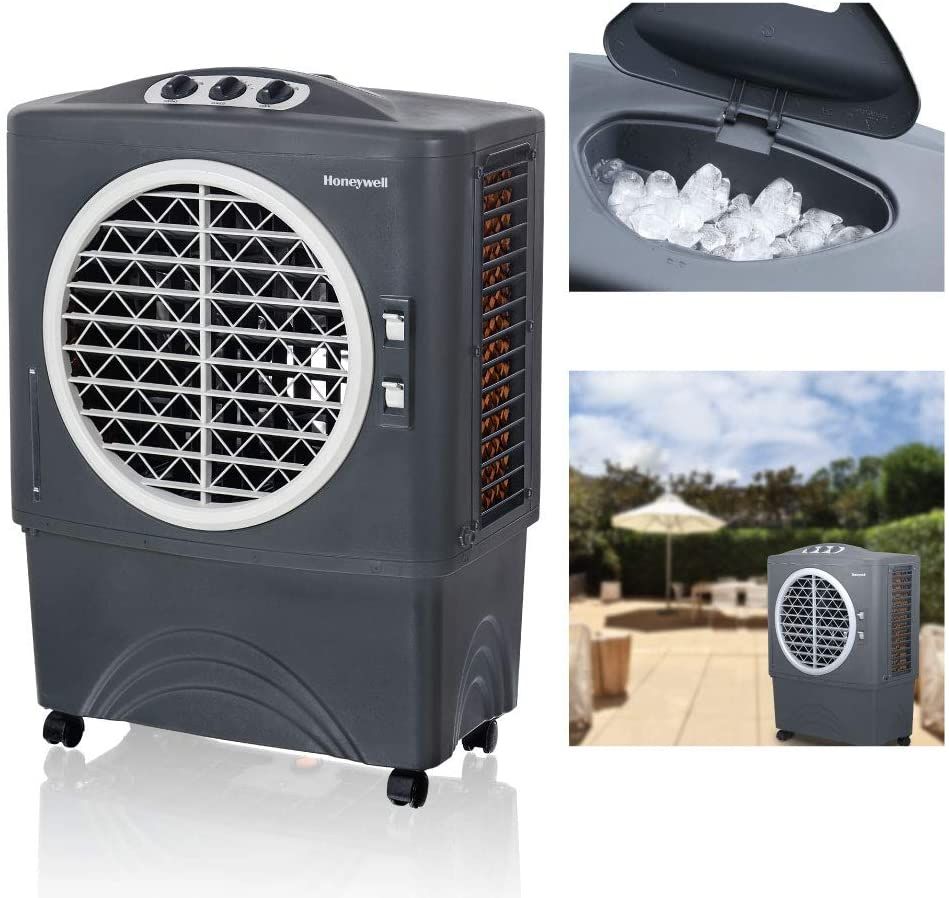
Star rating: 4.2/5
BTU: N/A (1062 CFM)
Size: 14.8” x 24.4” x 34.1”
Best for: Large group camping trips in desert climates
As I mentioned above, evaporative coolers, or “swamp coolers,” have their advantages.
The breeze they emit is similar to the kind of temperate climates you’ll find near a body of water, like a refreshing sea breeze.
The Honeywell Evaporative Air Cooler also has a simple water-powered cooling system. It uses a large-capacity 10-gallon water tank and a top-loading ice compartment for extra cooling power.
Because evaporative coolers add moisture to the air, they work best in hot, dry climates instead of humid climates.
And as a bonus, they draw considerably less energy than a traditional air conditioning unit.
The Honeywell Evaporative Air Cooler even comes with an extra-long cord to help connect your tent to your power source.
Although it’s a little pricey for an evaporative cooler, this tank-like unit is a heavy-duty air cooling system from a trusted brand.
It also has a durable, weatherproof body, and honeycomb filters line the unit on three sides, so the airflow spreads out in three directions without drawing too much power.
PROS
- Energy-efficient
- Ice compartment
- Long cord
CONS
- Water and ice need to be refilled
- Not as much cooling power as a traditional air conditioner
#3 Zero Breeze Mark 2 Battery Powered Portable Air Conditioner
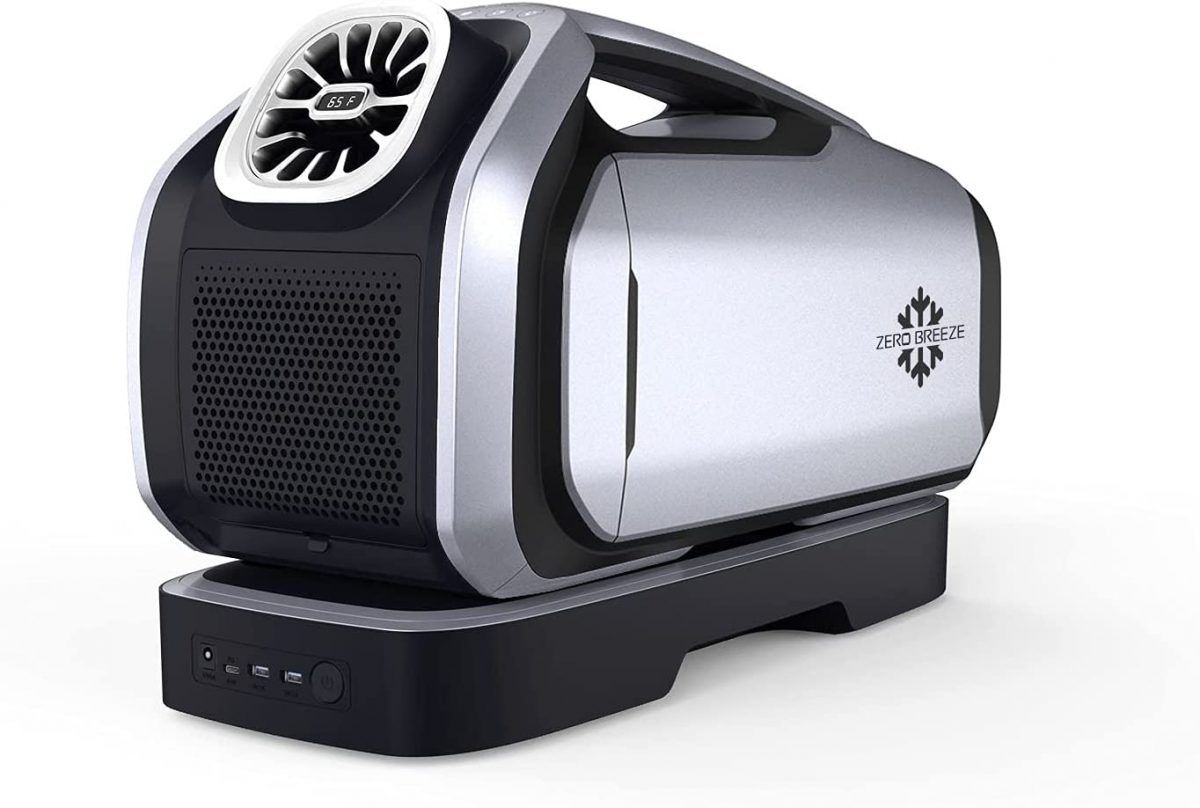
Star rating: 4/5
BTU: 2300
Size: 20” x 10” x 11”
Best for: Off-grid summer camping trips in a small tent
The innovative Zero Breeze Mark 2 Air Conditioner is one of the only battery-powered tent air conditioners on the market.
And it’s the only air conditioner on this list intended for use inside a tent. For that alone, it deserves a spot.
Also marketed for use in RVs or to outfit your pop-up camper with an AC, this battery-powered AC unit has 2300 BTUs, and you can run it without the need for a power cord.
You can expect the battery to last about three to five hours.
And while it has a definite cooling effect, it doesn’t have a high enough BTU to cool large camping tents or uninsulated tents effectively. It also doesn’t have exact temperature settings.
However, in small spaces with extra insulation, the Zero Breeze Mark 2 can lower your tent’s temperature without the need for a power supply.
It’s an excellent addition to a summer camping trip in the wilderness.
One thing to note is that you’ll need to exhaust out the heat that the unit generates, which requires an airtight exit point for your hose.
Lastly, at just 16 pounds, this AC is a fraction of the weight of other units on this list, making it easily portable. It also comes with a remote control and an exhaust system.
PROS
- It uses battery-power
- Has higher cooling power than a fan
- Relatively small
CONS
- Lower BTU than a wall-powered air conditioning unit
- Battery power needs recharging
CHECK PRICE ON:
#4 Pro Breeze Smart Air Conditioner
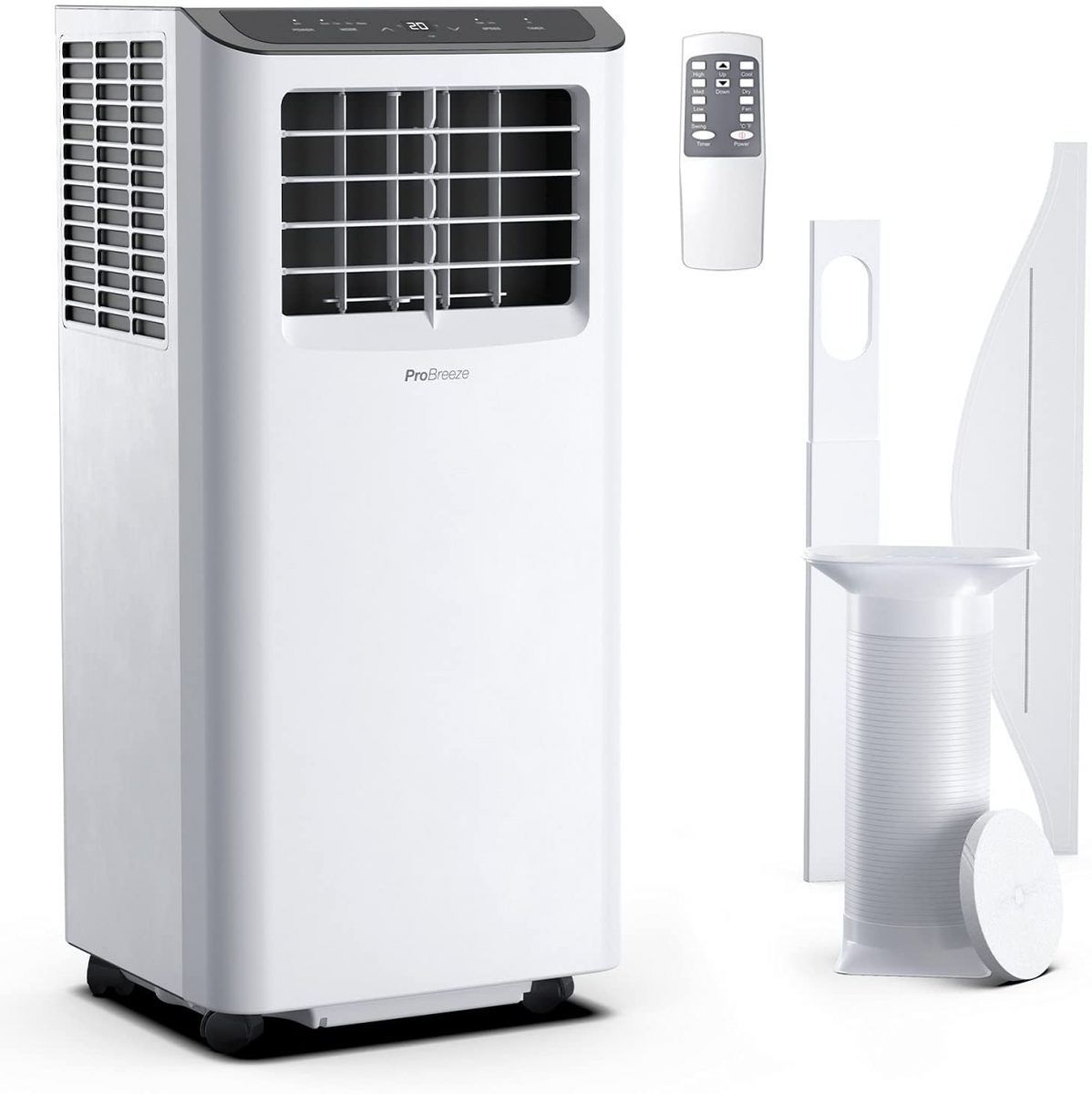
Star rating: 4.5/5
BTU: 10,000
Size: 12.6″ x 11.4″ x 27.6″
Best for: Very hot days in a fully-equipped RV park
When you’ve run through the limited low-power options, and you’re ready to spring for some luxurious tent cooling action, take a look at the Pro Breeze Smart Air Conditioner.
Swamp coolers and battery-powered ACs have their benefits at the right time and in the right place.
However, nothing gives you the same level of cooling power as a traditional air conditioner unit, which uses chemical refrigerants to remove balmy air from an enclosed space.
The Pro Breeze unit has four modes and two fan speeds. It boasts an impressive 10,000 BTUs, so it can fill a family-sized tent with cooled air.
It also scores a high energy efficiency rating and uses a greener refrigerant chemical called R410a. This means you can feel better about the environmental impact of using this AC unit while camping.
With that said, to use this unit, you’ll need to either have a powerful enough generator or be in a location with a solid power source, such as an RV Park or near a home.
If you’re tent camping in an on-the-grid location, you may also have access to WIFI.
If that’s the case, you’ll be able to take full advantage of Pro Breeze’s state-of-the-art smart capabilities and voice command.
If you’re not in an area with WIFI, you can still operate this air conditioner with the controls on the display, as well as with a wireless remote.
This freestanding portable AC unit also requires a hose to cycle the hot air out of the tent. But with the correct setup, it makes for a high-quality air conditioner for camping.
PROS
- Powerful BTU
- Freestanding
- Voice controls and smart capabilities
CONS
- Not suitable for off-grid camping
- Exhaust hose sold separately
#5 TOSOT Portable Air Conditioner
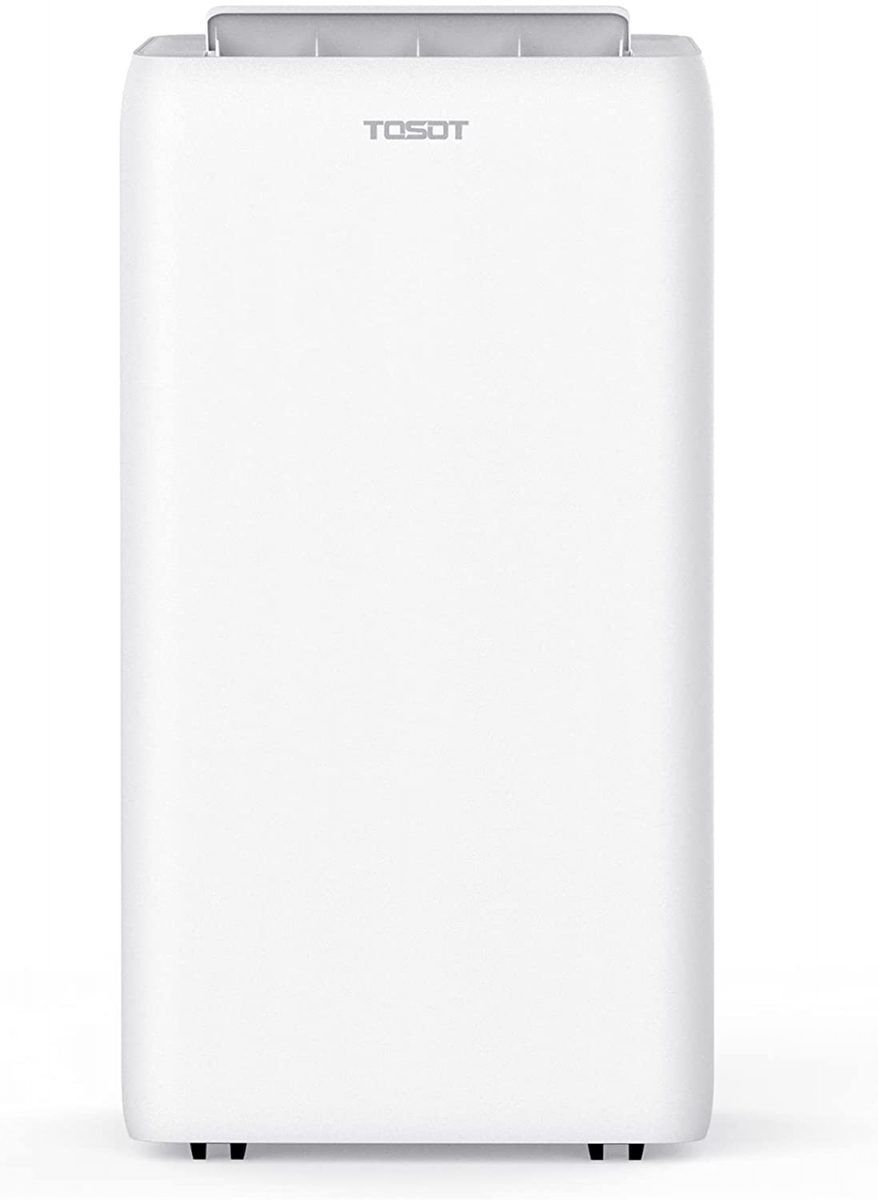
Star rating: 4.7/5
BTU: 12,000
Size: 16” x 17” x 32”
Best for: Cooling down large cabin tents
If you’re looking for super-powerful air conditioners for camping, the Tosot Portable Air Conditioner might be for you.
This camping AC unit also requires an exhaust hose not included in the package and must be plugged into a power source such as a generator.
But once hooked up, it has an impressive 12,000 BTUs, which can cool up to 450 sq feet of indoor space.
Because a tent has thinner walls, you won’t get quite as much square footage, but with 12,000 BTUs, it can still cool an uninsulated 10-person tent.
The Tosot Air Conditioner also doubles as a dehumidifier that can help curb condensation inside a tent.
This powerful appliance can remove up to 81 pints of water from the air per day. It also has a fan-only mode for when you just need a light breeze, and it too uses a greener refrigerant.
Its swing function blows cold air in all directions to help air-condition the space faster. Plus, the filter is removable and washable for headache-free maintenance.
PROS
- Impressive cooling power
- Three different modes
- Swing function cools in all directions
CONS
- Needs power source
- Heavy
#6 Honeywell Portable Air Conditioner, Dehumidifier, and Fan
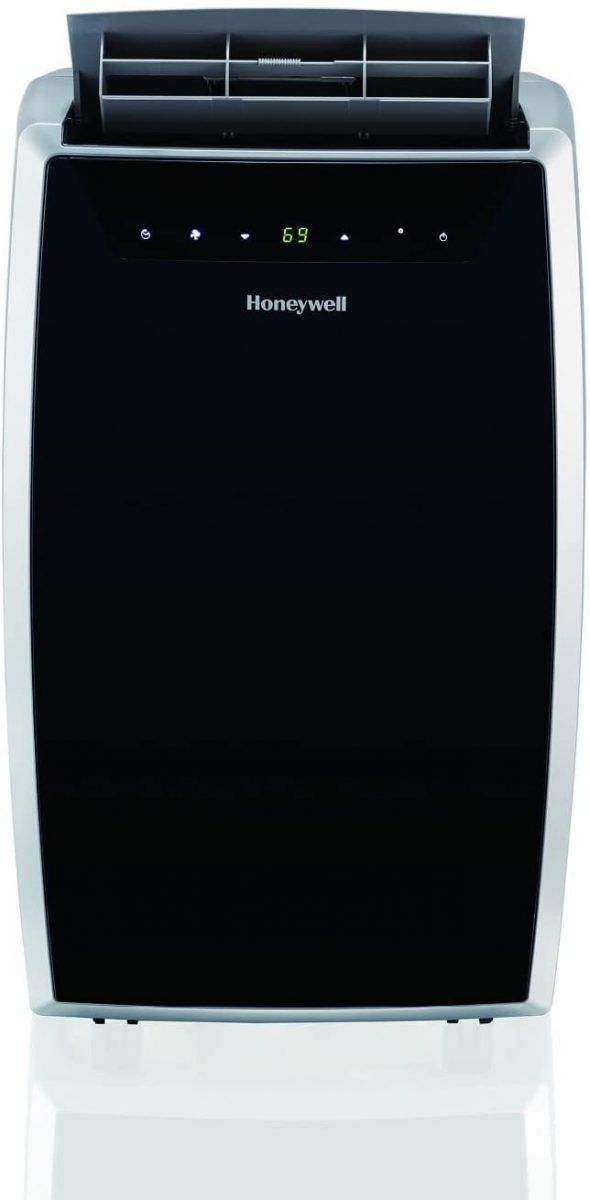
Star rating: 4.5/5
BTU: 14,000
Size: 15.2” x 18.1” x 29.4”
Best for: Glamping in spacious bell tents
Next up is the Honeywell Portable Air Conditioner. If you’re hoping to keep a 10+ person tent cool, and a power source isn’t an issue, this unit is for you.
This air conditioner packs a powerful 14,000 BTUs. However, with great power comes great electricity usage, so you’ll need a solid power source for this one.
It also should be noted that this unit weighs 70 pounds, so it’s pretty heavy.
With that said, the Honeywell Portable Air Conditioner would work excellently if you’re looking to glamp in luxury tents with air conditioning.
Most tent stove jacks are between 5-8 inches in diameter, and the hose for this unit is a little under six inches.
So a canvas tent with a stove hole could quickly adapt to become a tent with an air conditioner port, keeping your spacious bell tent perfectly cool in the summer heat.
This air conditioner comes with a battery-operated remote control and a removable, washable filter.
It also has three fan speeds and functions as a dehumidifier, so it’s great for hot and humid climates.
The dehumidifier option can remove up to 51 pints of moisture from the air over 24 hours. And it drains continuously, keeping it low maintenance and making it an excellent portable AC for camping.
PROS
- Super powerful cooling capabilities
- Dehumidifier
- It comes with remote control
CONS
- It needs a lot of power
- Somewhat heavy
#7 Barton Portable Air Conditioner
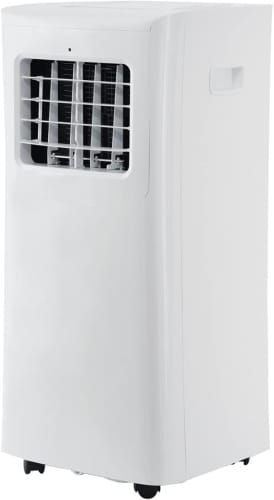
Star rating: 4.4/5
BTU: 8,000
Size: 13.4″ x 13″ x 28.2″
Best for: Smaller tents in hot weather
For a smaller tent, 14,000 BTUs might be overkill.
If you want the power of a proper air conditioner but you only have a smaller tent, then the Barton Portable Air Conditioner is a solid choice.
This lightweight air conditioner comes with wheels, so it’s easy to move around. It’s also reasonably compact, so it’ll fit inside a tent that’s on the smaller side.
This small portable outdoor air conditioner has four settings: cool, dehumidifier, fan, and sleep, and you can set it and forget it for 24 hours at a time.
It also has various handy features, such as dual fan speed options and a smart temperature sensor.
And it comes with a remote control and an LED digital display to control the exact temperature. The package also includes a hose kit to cycle the warm air out.
For its compact size compared to how much cooling power it has, this unit will please camping enthusiasts looking to bring an air conditioner with them on their next trip.
PROS
- Smaller and more lightweight than competing units
- Portable with wheels
- Four settings
CONS
- Not as powerful
- Exhaust hose not included
#8 ZAFRO Portable Air Conditioner
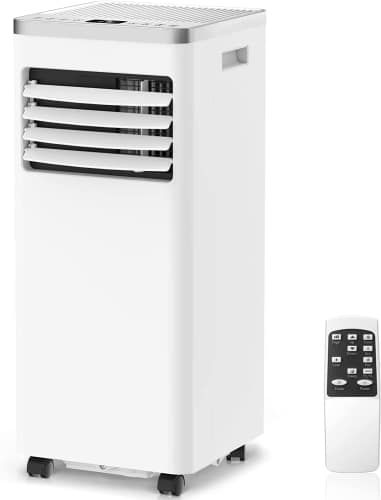
Star rating: 4.8/5
BTU: 10,000
Size: 27.3” x 13.7” x 13.6”
Best for: Tent camping with a generator
The ZAFRO Portable Air Conditioner packs a punch.
Although a little pricey, it’s decently small and lighter in weight than competing portable air conditioners while still managing a substantial 10,000 BTUs.
That’s enough to cool an insulated ten-person tent and an uninsulated eight-person tent without taking up too much space.
Like most portable units, this one will need a hose, but this AC comes with a complete window exhaust kit, including the hose and all the connections.
Another of this air conditioner’s valuable features is that it includes a reusable and washable dust filter, making it an air purifier as well as a conditioner and dehumidifier.
This could improve your camping experience in a hot, dry, and dusty climate by keeping the air inside the tent cool and breathable.
PROS
- High cooling power
- Compact size
- Comes with hose
- Washable filter saves you money in the long run
CONS
- Expensive
- It uses a lot of power
#9 Koldfront Window Air Conditioner
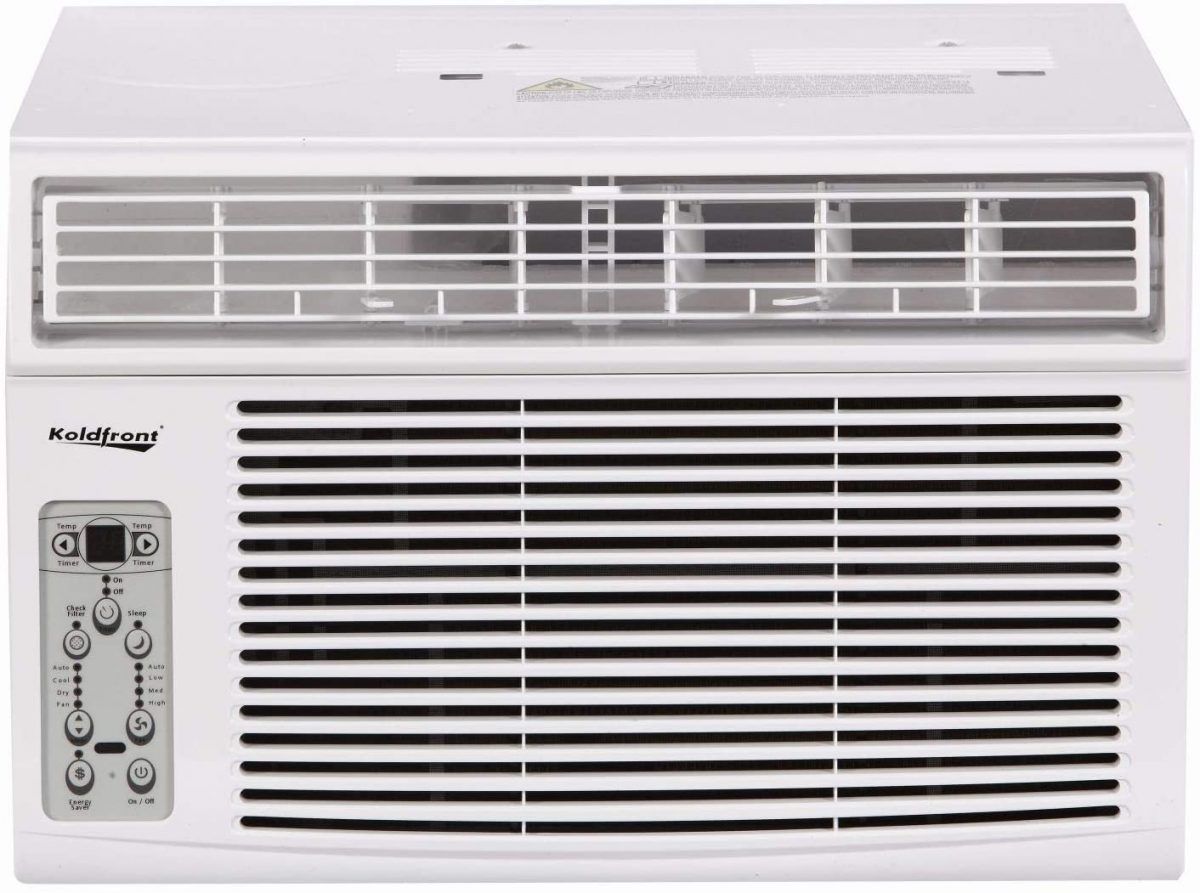
Star rating: 4.5/5
BTU: 8,000
Size: 15.8” x 18.6” x 13.4”
Best for: Medium tents with an AC port
Window-mounted air conditioners are effective tent AC units, as long as the tent has an AC port.
A few tents come with an AC port already installed, but in other cases, you can create a port at the door of your tent.
You can theoretically cut a hole in your tent, but this is tricky, and you’ll need to make sure the hole is airtight.
However, the payoff is worth it – a window AC unit can cool a tent more effectively than a freestanding portable AC with the right retrofitting.
The Koldfront Window Air Conditioner makes an excellent portable ac unit for several reasons.
First off, it’s pretty small and not heavy for its size, and it also has a dehumidifying function for those hot, muggy days.
This compact window AC is also energy-star rated and has an energy-saving mode that causes it to cycle off when it senses the area is cool enough.
Even if you have a power source on your camping trip, electricity will likely still be limited, so a unit that uses up less power is always an advantage.
The Koldfront Air Conditioner is also reasonably-priced and has a respectable 8,000 BTUs of power.
You should note that, like many window units, the Koldfront emits a somewhat loud humming sound, so if you’re sensitive to noises like this, you might want to keep looking.
PROS
- Compact
- Energy-saving
- Dehumidifier
CONS
- Requires some tent alterations
- Somewhat loud
#10 Midea U Inverter Window Air Conditioner
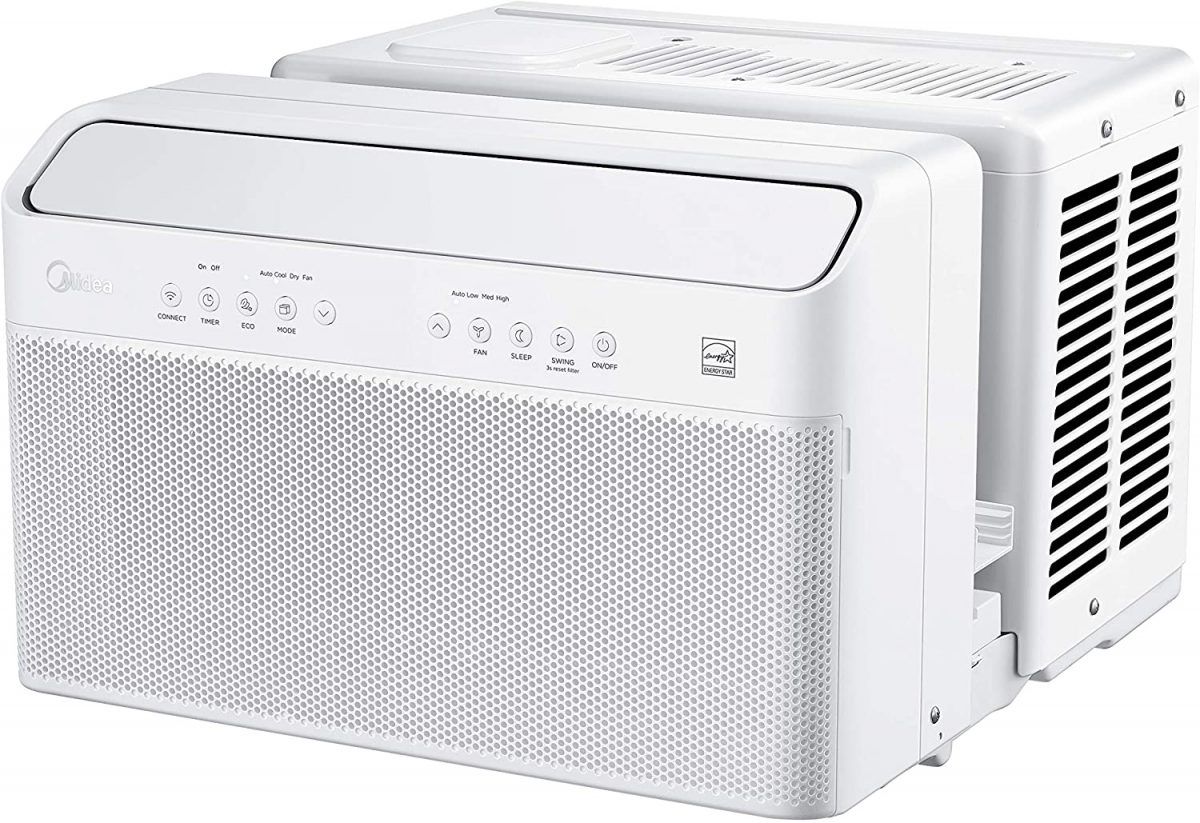
Star rating: 4.5/5
BTU: 8,000
Size: 19.17″ x 21.97″ x 13.46″
Best for: People who are sensitive to sound
The Midea U Inverter Window Air Conditioner has many of the same advantages as other camping air conditioners, such as a dehumidifying feature and impressive energy conservation.
In fact, it’s the first window-mounted AC unit to earn the distinction of an Energy Star Most Efficient 2020 Certification, putting it well ahead of the pack when it comes to eco-friendliness.
Although it’s a bit larger and heavier than the Koldfront model and has the same 8,000 BTU cooling power, it stands apart because it’s very quiet.
The unique U-shaped design separates the back of the air conditioning unit from the front, which quiets a lot of the noise from the machine’s operations.
The noise-muffling design works best in an actual window because the glass creates a solid barrier. Still, it should have some muffling effect in a tent because the sound-generating mechanism will be outside and the side that emits cold air will be inside.
This U-shaped design may also simplify the task of installing it for tent air conditioning, as it won’t need as big of an opening, making it easier to keep the hole airtight.
PROS
- Superior energy conservation
- Special design for quiet
- Dehumidifier
CONS
- A little pricier than other options
- A bit heavy
#11 AmazonBasics Window-Mounted Air Conditioner
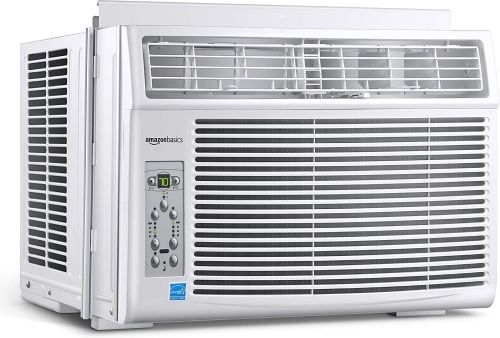
Star rating: 4.5/5
BTU: 6,000
Size: 13.39″ x 18.54″ x 15.75″
Best for: Cooling down a family-sized tent that has an AC port
If you’re looking at cost-effective but powerful window air conditioners, the AmazonBasics Window-Mounted Air Conditioner is an excellent option.
It has a very impressive cooling capacity of 6,000 BTUs while remaining reasonably priced.
The AmazonBasics AC isn’t the smallest window unit or the lightest, but it’s Energy Star rated, and it comes with a washable, reusable filter.
It has three fan speed settings, as well as auto-shutoff, adjustable air direction, and sleep mode. It’s fairly quiet except when operating at full speed. Make sure to inspect it fully upon receipt, as sometimes quality control is lacking.
This unit is going to need an extension cord, as is normal for a tent AC unit because you’re likely going to need to plug it in at a distance.
This air conditioning unit also comes with a remote control for easy operation.
PROS
- Energy-efficient
- Can cool 250 sq ft
- Low price
- Remote control
CONS
- Heavy
- Large
Buying Guide: How to Choose the Best Tent Air Conditioner
Choosing a camping air conditioner can feel a bit like sailing in uncharted waters.
As this is a somewhat new trend in camping, and there isn’t yet a big commercial market for them, you’re going to need to get creative, which can be daunting.
But don’t worry, we’ve broken down everything you should consider when shopping for camping air conditioners.
What to Look for in a Tent Air Conditioner
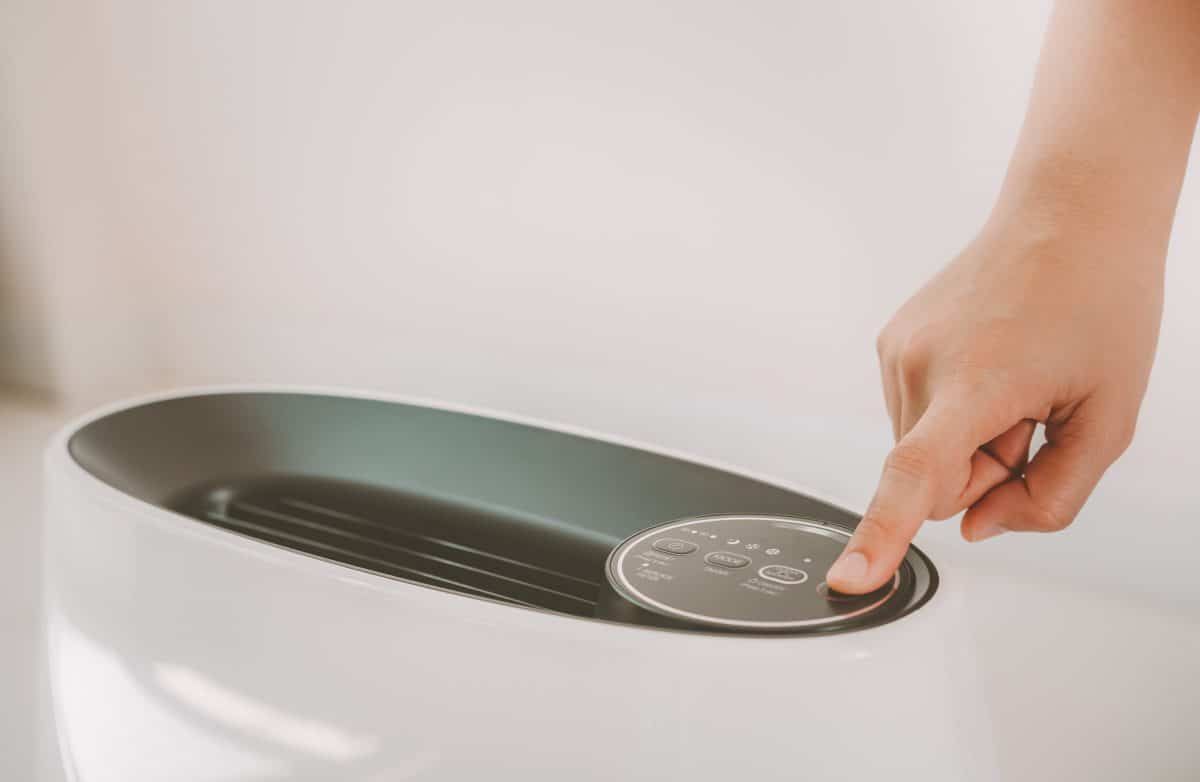
When you’re buying a camping AC, there are several qualities to keep an eye out for. First, you’ll need to decide what kind of air conditioner you’re looking for.
Your access to power will be the major factor in deciding which tent AC is best for you.
Whether or not you’re going to be using this air conditioner in a situation where you have access to ample electricity will determine which category of air conditioner to choose.
Once you know what you’re shopping for, these are some elements to consider.
Cooling Power
The next thing on your list should be the product’s tent-cooling abilities. For traditional air conditioners, you’re going to need at least 5000 BTUs to cool a small, uninsulated tent.
Larger tents will need even more BTUs, so keep in mind the size of your camping tent as you shop, and try to not buy anything under 5000 BTUs.
Size and weight
Whenever you’re buying any gear for camping, the weight will be an important factor since you’ll need to carry that gear for at least a short distance if not more.
If you’re buying a portable air conditioner, you’ll also want to make sure it’s small enough to fit inside your tent.
Many freestanding portable AC units have wheels, so it’s not as much of an issue if they’re heavy.
However, window units tend to be unwieldy and weigh a lot, so look for a smaller, slimmer window AC unit to reduce your stress as you set up camp.
Extra Features
Another thing to look for in an air conditioner for camping is its extra features.
Does it have a dehumidifying function? What about a washable filter? Does it have WIFI compatibility and is that something you need? Does it come with an exhaust hose?
Special features such as these can set a unit apart from the pack because they’ll help the unit adapt to being a tent AC unit.
Energy Efficiency
Even when you have unlimited access to electricity, energy efficiency is essential.
At the very least, an energy-efficient unit will save you money on your power bill or conserve the power from your generator.
ACs tend to drain a lot of electricity, so any way to cut that down will be beneficial.
Types of Tent Air Conditioners
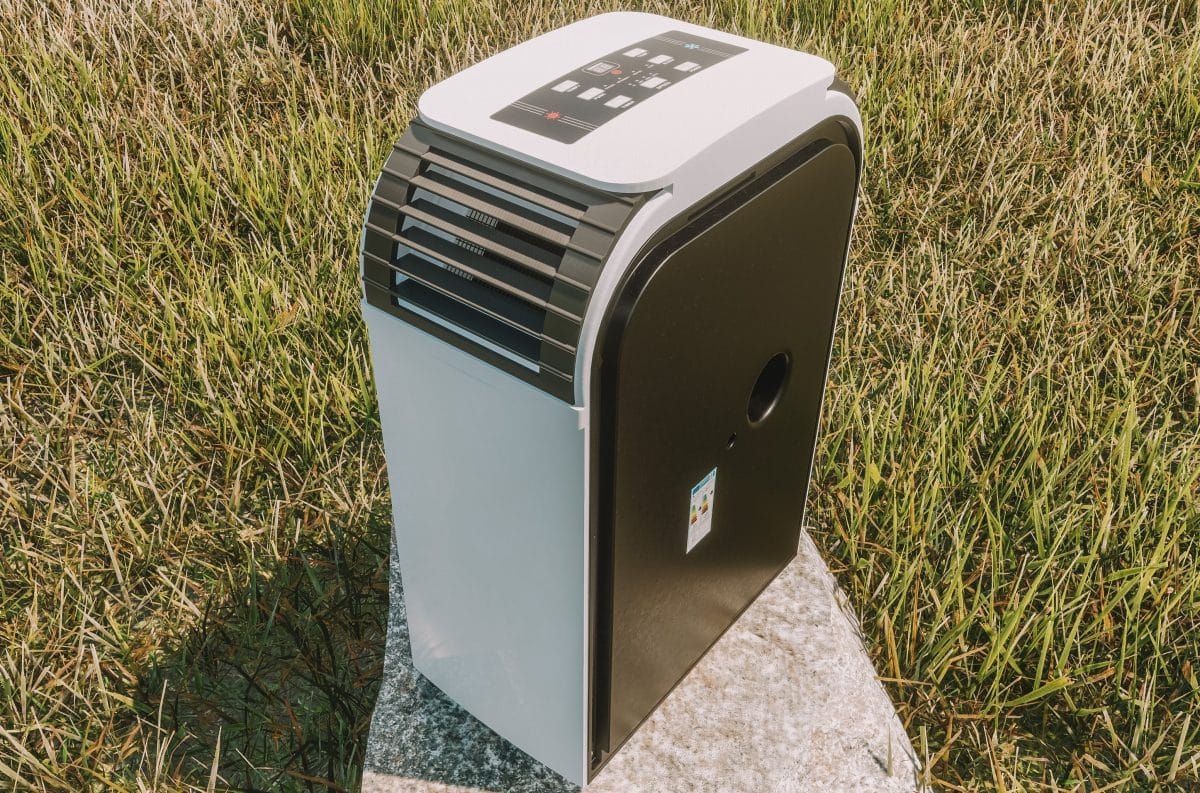
Portable Freestanding
Portable air conditioners are freestanding and rectangular, and they often come with wheels so they’re easy to move.
These types of air conditioners use electricity, so you’ll need a generator or another power source nearby to run them.
They also have excellent cooling abilities because they use a chemical refrigerant to cool the air.
Portable air conditioners can go inside a tent, but also need to have a hose leading out of the tent through an opening that’s as airtight as possible.
This is to remove the hot air that the portable tent air conditioner puts out as it runs.
Window Air Conditioner
Window air conditioners can function as effective tent air conditioning units as long as the tent is appropriately adapted.
In a house, window air conditioners sit on a window sill, and the back of the unit blows the hot air out while the front blows cool air into a room.
For a tent, you’ll need an airtight AC port for the unit to sit in. A few tents on the market come with a rectangular ac port.
It’s also possible to cut your own port or set one up in the doorway to the tent, but you’ll want to add fabric to block the area around the tent air conditioner.
You’ll also need to build a little stand for the window unit so that it’s off the ground and supported the way a windowsill would support it.
Window air conditioners also need a power generator or power source nearby to operate. Some window AC units can have pretty high noise levels, so that’s something to look out for as well.
Evaporative Air Coolers
The third type of tent air conditioner is a departure from the rest. An evaporative cooler uses water instead of a chemical refrigerant to cool the air.
If you’ve ever noticed that the temperature becomes more moderate as you approach a lake or beach, it’s because of the added moisture in the air. Swamp coolers use the same idea.
Evaporative coolers, otherwise known as swamp coolers, use considerably less electricity than traditional air conditioners, but the cooling effect is also less powerful.
They work best in hot and dry climates instead of humid air due to the amount of moisture they add back into the air.
Many evaporative coolers also use ice packs or ice compartments to boost the cooling capacity. This means that you’ll need to keep refilling the water and ice as it runs.
Many swamp coolers also run the water through filters, and you’ll need to make sure these filters dry out properly before you store it. Otherwise, mold and mildew can form and leakage can occur.
Evaporative coolers don’t require exhaust hoses or venting systems to run, so you won’t need to retrofit your tent to cool it with one.
Battery-Powered Air Conditioners
This type of tent air conditioner is the most limited category.
Air conditioners need a lot of energy to remove heat from the surrounding air, and batteries generally have trouble doing this, especially over long periods.
Although there are a few others out there, the most prominent battery-powered air conditioner on the market is the Zero Breeze Mark 2, which can muster 2,300 BTUs.
This is a pretty impressive output for a battery-powered unit. However, it’s still not enough to cool large tents.
There are also several battery-powered evaporative coolers on the market. Like other evaporative coolers, these have less cooling power than traditional ACs and limited battery life.
FAQs About Tent Air Conditioners
A tent air conditioner is a new and novel idea so you probably have a few burning questions about how it works.
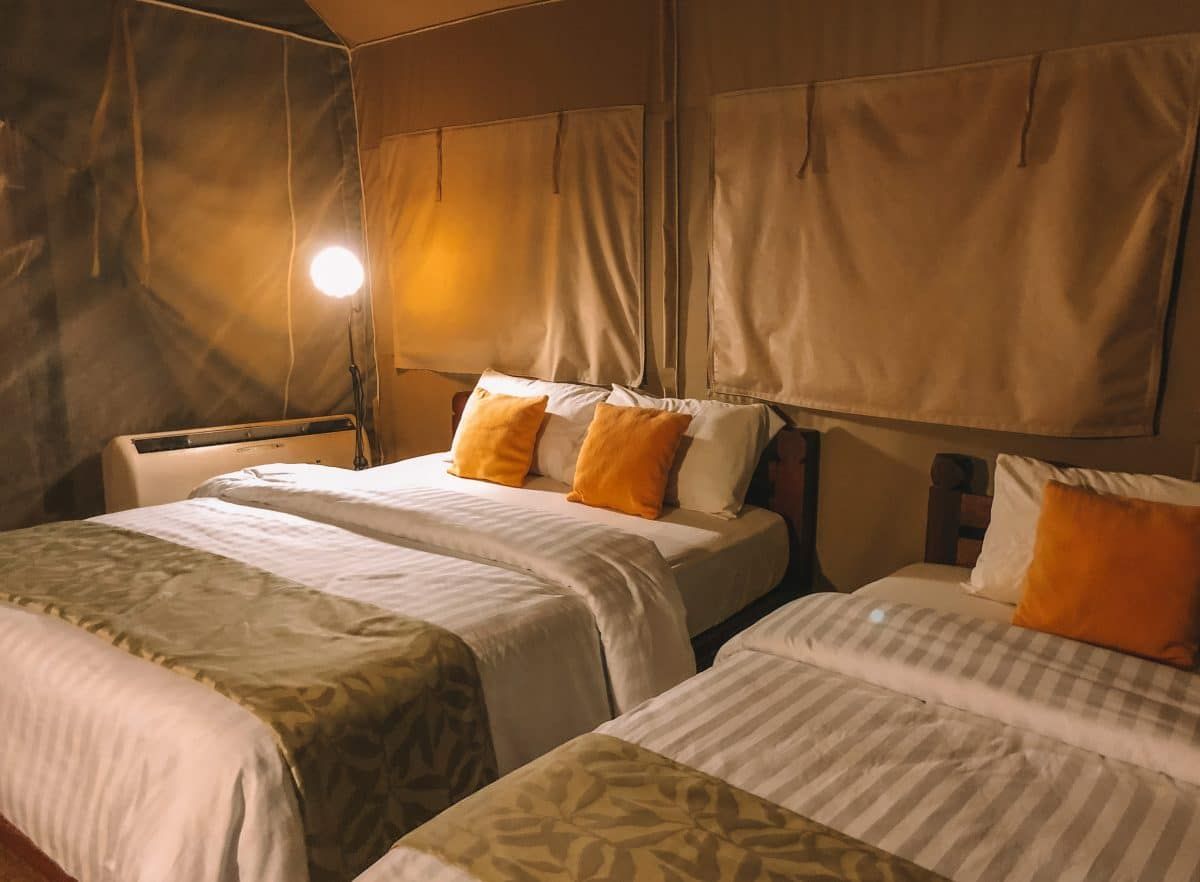
How do you put an air conditioner in a tent?
There are several ways to set up a tent with an air conditioner, depending on what type of tent air conditioner you have.
Portable units and evaporative coolers can go right inside the tent, provided they fit. Portable units need a hose to funnel out the warm air, while evaporative coolers only need an electrical cord port.
Window air conditioners are a little more complicated, but they can have a powerful cooling effect when done correctly. This type of unit needs an airtight AC port and a platform.
For every tent air conditioner aside from the Zero Breeze Mark 2, you’ll need an extension cord to connect your unit to a power source.
How do you cool a tent with AC?
There are a few key things to remember if you want to air condition your tent.
First, the walls of a tent are much thinner and much less insulated than a solid structure, and you’ll need ample BTUs to combat the inevitable leakage that will happen.
You’ll also need to combat that leakage by making your tent as airtight as possible. Your air conditioning unit will either be partially outside your tent, or else it will have a hose leading to the outside.
Either way, part of it will need to pass through a hole, and you’ll want to plug up the edges around that hole as best as you can.
Insulating your tent with an extra tarp or a rainfly is another way to enhance the cooling capacity of tent air conditioners.
Can you put a window AC unit in a tent?
You can put a window AC unit in a tent, and this can be an even better option than a portable air conditioner.
You’ll just need the proper setup for a window AC unit to work as a tent air conditioner.
Window ACs tend to be big, heavy cubes made from metal, plastic, and styrofoam, and your camping setup will need to include a way to support the unit up off the ground.
You’ll also need a tent with an airtight opening that allows the back half of the unit to stay outside while the front half blows cool air into the tent’s interior.
Does an air conditioner really work in a tent?
With a bit of ingenuity, an air conditioner can work well inside a tent and provide comfortable relief from the summer heat.
And ACs with a dehumidifying setting can be incredibly convenient inside a tent because they help with the moisture that accumulates there.
Except for the Zero Breeze Mark 2, which has limitations, most tent cooling systems require an electrical hookup.
A powerful enough generator will run an AC unit. Or, if you’re using your tent air conditioner in a glamping site that’s close to a house, you could use the electricity from there.
In the market for a new tent? Don’t miss our guides to the best 4-person tent, 6-person tent, 8-person tent, 10-person tent, 12-person tent, 3-room tent, cabin tent, pop-up tent, instant tent, waterproof tent, insulated tent, winter tent, tent with a stove jack, tunnel tent, and inflatable tent.
Or maybe you’re looking for more gear to keep you cool on your next camping trip. Check out the best camping canopies, best coolers for camping, and best Yeti alternatives.
How much do tent air conditioners cost?
The price of tent air conditioners varies widely depending on the unit type.
For portable air conditioners, expect to pay at least $300.
High-quality window units can range up to pretty high prices, but there are also plenty on the market for around $200 that make good tent air conditioners.
An evaporative cooler will be less expensive, usually falling somewhere between $100 and $200.
Conclusion: Our Pick for the Best Tent Air Conditioner
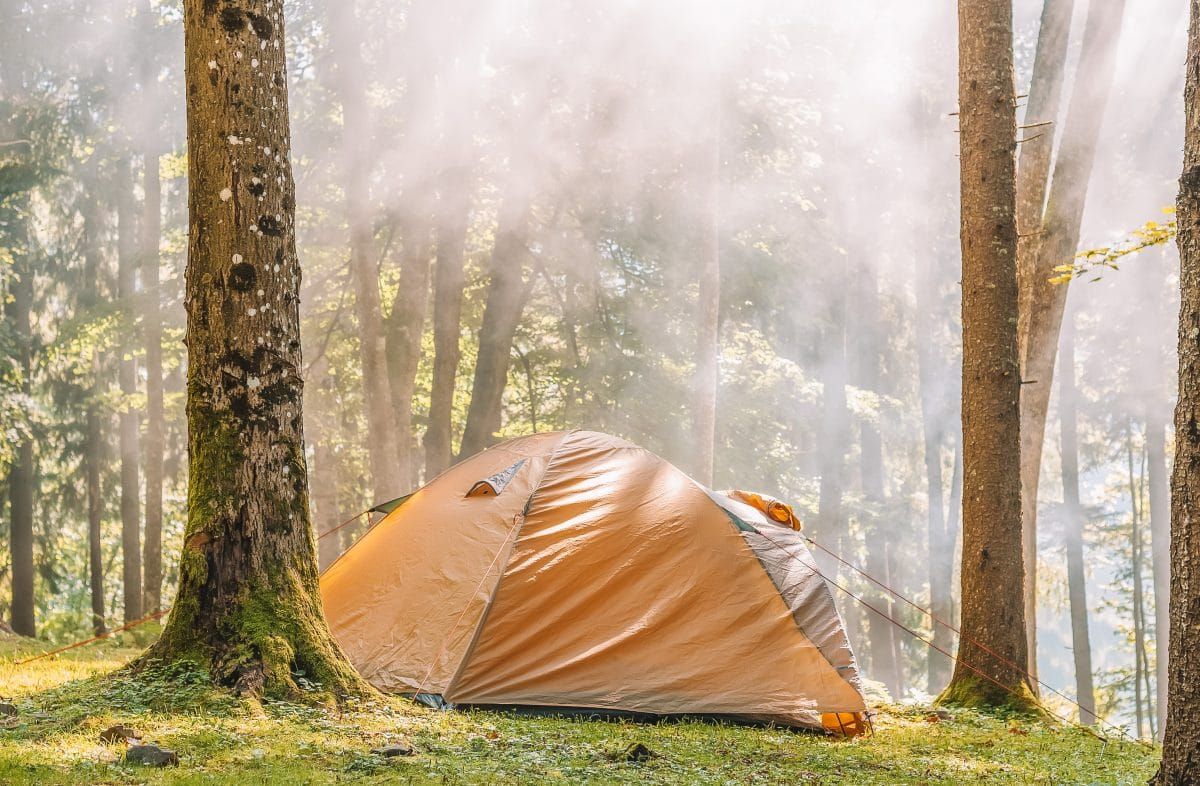
With all these options, it might be difficult to decide which is the best one for you.
My picks for the air conditioners are the Midea U Inverter Window Air Conditioner, a window unit, and the Honeywell Portable Air Conditioner, a freestanding portable AC.
Ultimately, these two types of air conditioners win out over evaporative coolers and battery-powered ACs due to their superior cooling capacity.
An evaporative cooler uses less energy, but it still needs electricity. If you’re going to bring out the extension cord, you’re better off plugging it into an appliance that will effectively cool down your tent.
The Midea U Inverter Window Air Conditioner has everything you’d want in a window unit that you’re going to use as a camping air conditioner.
First off, it has impressively low noise levels and superior energy efficiency, both of which give it an edge over other window tent AC units.
Its quietness comes from its unique U-shaped design, which could also help adapt it more easily to a camping tent.
This air conditioner also has smart controls and WIFI capabilities, in case you prefer camping on-the-grid instead of off it. And it has 8,000 BTUs, which is ample to cool a medium-sized tent.
The Honeywell Portable Air Conditioner is an excellent choice if portable air conditioners are more your style.
Honeywell is a trusted brand, and this air conditioner is durable. And at 14,000 BTUs, this unit has enough cooling capacity for a spacious 10-person tent.
It is also comparatively lighter than other products with a similar cooling capacity, and it comes with a removable, washable filter, so you won’t need to keep buying them.
Additionally, the Honeywell Portable Air Conditioner helps you manage the moisture inside your tent with a built-in dehumidifier and an auto-evaporation function. Plus, it’s very quiet.
ABOUT THE AUTHOR

Elina Ansary
Growing up in Northern California, Elina camped often with her family. These days, she’s based in Upstate New York, working on building an off-grid studio space with her husband in the Catskills. These days, Elina visits artist residencies in locations around the world, including Amsterdam, Finland, Italy, and Australia, and has exhibited her work in galleries and museums in the US and abroad. When she isn’t writing and editing for The Atlas Heart, Elina is pursuing a Master’s degree in Visual Art at Cornell University and splits her time between Ithaca and Brooklyn.
Looking for more outdoor gear recommendations? Check out our related posts below!
Best Screen Houses for Camping Bug-Free
Best Heated Gloves for Cold Weather
Best Hammocks with a Mosquito Net
Best Reclining Camping Chairs with a Footrest
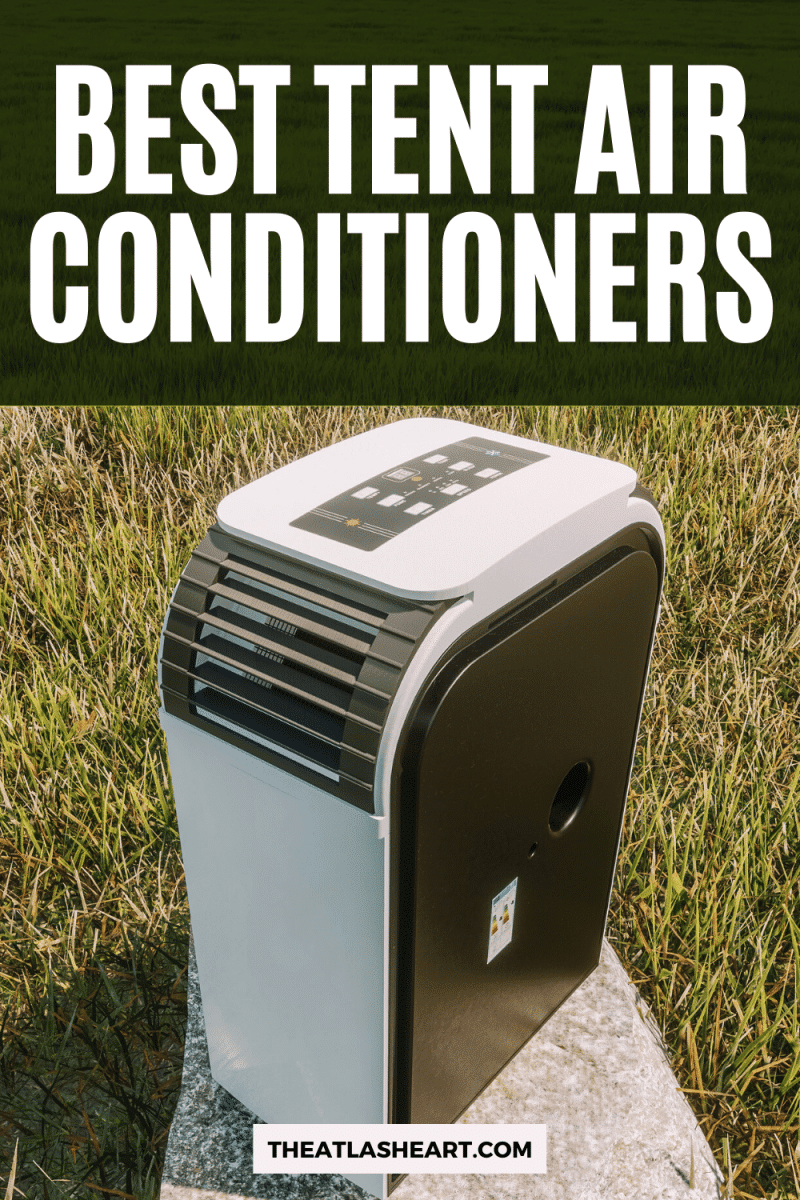
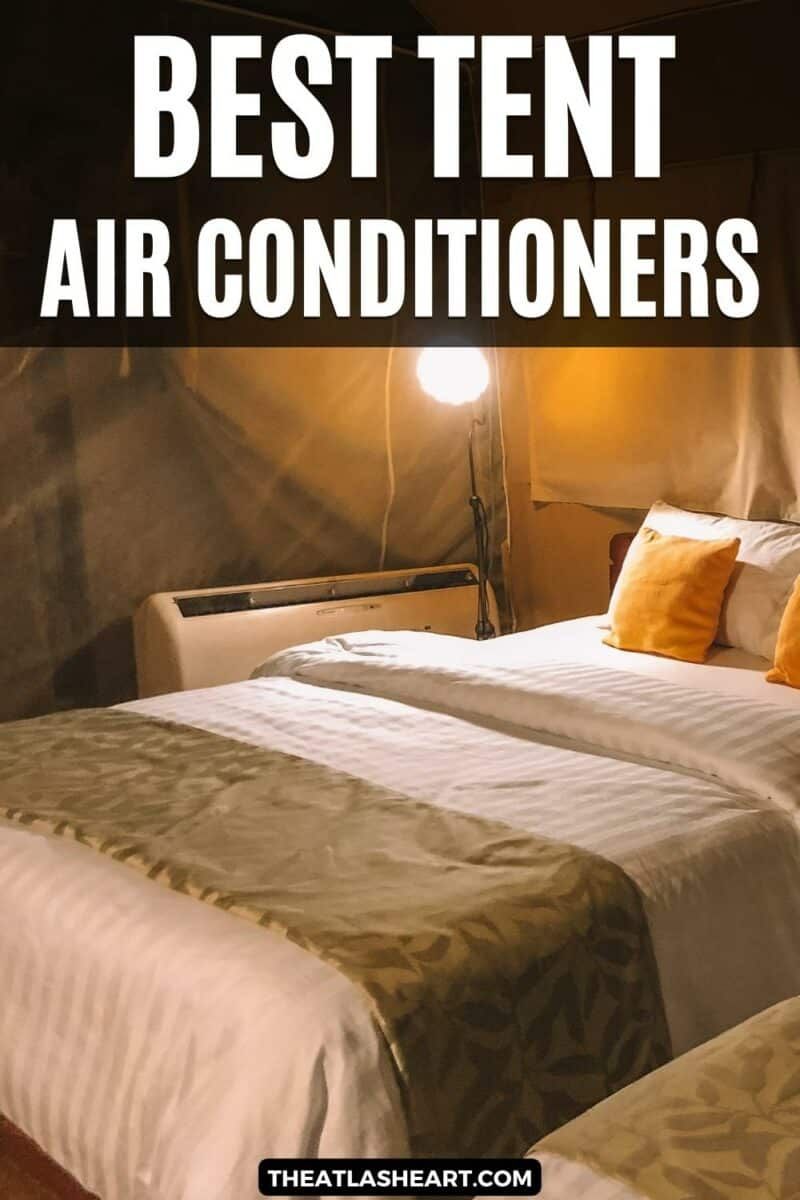
Pin one of these images for future reference


